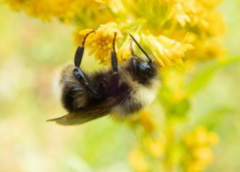Climate change, urbanization and pesticides imperil wild pollinators

« Scientists Fail to Locate Once-Common CA Bumble Bees
Newswise — Several species of California bumble bees have gone missing in the first statewide census of the fuzzy pollinators in 40 years. If they can be found, a recent court ruling could help save them.
Smaller-scale studies have documented significant declines in bumble bee populations around the world due to climate change, development of wild habitat, and the use of bee-killing pesticides.
Led by UC Riverside, this study was an effort to document changes in bumble bee populations across large geographic areas in California since the last such study was done in the 1980s.
It is important to have data that substantiates the bees’ health. Bumble bees can fly in cooler temperatures and lower light levels than many other bees, and help pollinate crops worth $3 billion annually in the U.S. They perform a type of pollination required for plants including tomatoes, peppers and cranberries.
For the updated data, UCR entomologist Hollis Woodard’s research group collected bees from 17 total sites representing six different ecosystems previously known to host a large variety of bumble bees.
The team attempted to collect at four places in Southern California but could not locate more than 10 bees in those sites at the time of their visits.
The result of their collection efforts are documented in the journal Ecology and Evolution. In total, the team collected 17 types of bumble bees representing only 68% of the species historically known to inhabit the state.
“Although we found that relative to other sites the mountains are home to the most diverse bumble bee populations, even at those sites we also failed to find some species that used to be there,” Woodard said.
One of the missing species, the Western bumble bee is an important pollinator of wild plants and crops. It used to be one of the most common bumble bees in California.
“We didn’t find it even once,” Woodard said. “If it was okay, we should have seen it,” she said.
The most commonly found species was Bombus vosnesenskii, the yellow-faced bumble bee, which represented more than half of all bees the team collected. It is the dominant species in California.
“Even the most dominant species has lost a lot of suitable habitat since the last large-scale survey,” Woodard said. “The winner is not doing great.”
In each site where they could find bees, the research team sampled only 100, in an attempt to minimize harm to already beleaguered bumble bee populations. This approach was likely sufficient to capture the relative abundance of species at most of the sites in the study.
However, Woodard said that in some places with higher diversity, like the White or Sierra Nevada mountains, the team might have found additional species if they had collected more specimens.
“It’s possible in these places that if we’d taken 200 bees, we’d have continued to capture additional species,” she said.
The Western bumble, or Bombus occidentalis, is one of four bumble bee species cleared by the state’s Third Appellate District Court of Appeal for inclusion on California’s endangered species list.
None of these bees were found by the new census effort, and all of them are already on similar federal lists. State laws may afford them additional protections.
The U.S. Endangered Species Act prohibits listed wildlife from being trapped, taken or collected except for conservation or scientific purposes. State laws can complement these protections, and can address more specific, regional concerns.
“Generally, the state list directs more action toward more local measures. It’s good for them to be covered under both,” Woodard said. “I hope the state listing also encourages Californians to feel like they have a stake in helping the bees survive, because bees certainly help humans survive.”
Source: University of California, Riverside

Rod Washington: Rod is a blogger, writer, filmmaker, photographer, daydreamer who likes to cook. Rod produces and directs the web series, CUPIC: Diary of an Investigator. He also produces news and documentary video projects. Check out his podcast StoriesThisMoment at https://m3e.d71.myftpupload.com/stm-tncn-podcasts/



[…] Missing Bees? https://tnc.network/scientists-fail-to-locate-once-common-ca-bumble-bees/ […]
[…] Missing Bees? https://tnc.network/scientists-fail-to-locate-once-common-ca-bumble-bees/ […]